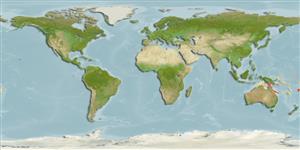>
Gobiiformes (Gobies) >
Schindleriidae (Infantfishes)
Etymology: Schindleria: Named for ichthyologist Otto Schindler, 1906-1959 (Prof. Dr. Konrad Schindler, pers. comm Dec. 2017); brevipinguis: From the small size of the species ('brevi') and the deeper, broader ('pinguis' = stout) body.
Eponymy: Otto Schindler (1906–1959) was an ichthyologist at Zoologische Staatssammlung München, Germany, where he was the first post-war Curator of Ichthyology (1949). [...] (Ref. 128868), visit book page.
Environment: milieu / climate zone / depth range / distribution range
Ecologie
marien rifbewoner; diepte 15 - 30 m (Ref. 52019). Subtropical
Western Pacific: Australia.
Lengte bij maturiteit / Grootte / Gewicht / Leeftijd
Maturity: Lm 0.7, range 1 - 0.8 cm
Max length : 0.8 cm SL (female)
Korte beschrijving
Determinatiesleutels | Morfologie | Morfometrie
Dorsale zachte stralen (totaal) : 13; Anale zachte stralen: 10 - 11; Wervels: 35 - 36. Body small, stout, unpigmented. Body depth at pectoral-fin origin 9-12% of standard length and at anal-fin origin 9-14% SL. First dorsal-fin ray at myomere 18-20 and first anal-fin ray below dorsal-fin ray 4. Vertebrae 20 + 15-16 = 35-36, myomeres 19-20 + 14-16 = 34-36. Premaxillae and dentaries lack teeth. Males have a rod-like, flexible urogenital papilla lacking lobes, projections, or accessory papillae, with distal half tapering to a blunt point and usually anteriorly directed.
Recently reported as the smallest vertebrate. Males average 7.7 millimeters long and the gravid female which is 8.4 millimeters weighed 1 milligram. This pedomorphic species has a life span of only 2 months, has dispensed its fishy appendages such as teeth and scales, and has no pigment except in the eyes (Ref. 52508). Specimens were collected in oblique plankton net tows (Ref. 52019).
Levenscyclus en paargedrag
Maturiteit | Voortplanting | Paaien | Eieren | Fecunditeit | Larven
Adults with mature gonads while retaining postlarval characters (Ref. 205). Distinct pairing (Ref. 205).
Watson, W. and H.J. Walker Jr., 2004. The world's smallest vertebrate, Schindleria brevipinguis, a new paedomorphic species in the family Schindleriidae (Perciformes: Gobioidei). Rec. Aust. Mus. 56:139-142. (Ref. 52019)
Status op de Rode Lijst van het IUCN (Ref. 130435: Version 2024-1)
Gevaar voor de mens
Harmless
Gebruik door de mens
Visserij: van geen belang
Tools
Speciale rapporten
Download XML
Internetbronnen
Estimates based on models
Preferred temperature (Ref.
123201): 26.1 - 27.3, mean 26.3 °C (based on 14 cells).
Fylogenetische diversiteitsindex (Ref.
82804): PD
50 = 0.5625 [Uniqueness, from 0.5 = low to 2.0 = high].
Bayesian length-weight: a=0.00389 (0.00180 - 0.00842), b=3.12 (2.94 - 3.30), in cm total length, based on all LWR estimates for this body shape (Ref.
93245).
Trofisch niveau (Ref.
69278): 2.9 ±0.4 se; based on size and trophs of closest relatives
Weerstandsvermogen (Ref.
120179): laag, minimale populatieverdubbelingstijd 4,5-14 jaar (Assuming Fec < 100).
Fishing Vulnerability (Ref.
59153): Low vulnerability (10 of 100).
